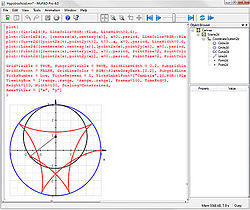- MuPAD
-
MuPAD 

Developer(s) The Mathworks Inc. Stable release Version 5.6 (R2011a) Development status Active Operating system Windows, Mac OS X, Linux Type Computer algebra system License Proprietary Website http://www.mathworks.com/discovery/mupad.html MuPAD is a computer algebra system (CAS). Originally developed by the MuPAD research group at the University of Paderborn, Germany, development was taken over by the company SciFace Software GmbH & Co. KG in cooperation with the MuPAD research group and partners from some other universities starting in 1997.
Until autumn 2005, the version "MuPAD Light" was offered for free for research and education, but as a result of the closure of the home institute of the MuPAD research group, only the version "MuPAD Pro" became available for purchase.
The MuPAD kernel is bundled with Scientific Notebook and Scientific Workplace. Former versions of MuPAD Pro were bundled with SciLab. Its version 14 release was adopted as the CAS engine for the MathCAD software package.
In September 2008, SciFace was purchased by MathWorks and the MuPAD code was included in the Symbolic Math Toolbox add-on for MATLAB. On 28 September 2008, MuPAD was withdrawn from the market as a software product in its own right.[1] However, it is still available in the Symbolic Math Toolbox in Matlab and can also be used as a stand-alone program.
Functionality
MuPAD offers:
- a computer algebra system to manipulate formulas symbolically
- classic and verified numerical analysis in discretionary accuracy
- program packages for linear algebra, differential equations, number theory, statistics, and functional programming
- an interactive graphic system that supports animations and transparent areas in 3D
- a programming language that supports object-oriented programming and functional programming
Often used commands are accessible via menus. MuPAD offers a notebook concept similar to word processing systems that allows the formulation of mathematical problems as well as graphics visualization and explanations in formatted text.
It is possible to extend MuPAD with C++ routines to accelerate calculations. Java code can also be embedded.
MuPAD's syntax was modeled on Pascal, and is similar to the one used in the Maple computer algebra system. An important difference between the two is that MuPAD provides support for object-oriented programming. This means that each object "carries with itself" the methods allowed to use on it. For example, after defining
A := matrix( [[1,2],[3,4]] )
all of the following are valid expressions and give the expected result:
A+A, -A, 2*A, A*A, A^-1, exp( A ), A.A, A^0, 0*A
where A.A is the concatenated 2×4 matrix, while all others, including the last two, are again 2×2 matrices.
References
External links
- MuPAD Research Group official site
- SciFace Software, MuPAD distributor
- MuPAD community online magazine
Computer algebra systems Retail Algebrator · ClassPad Manager · LiveMath · Magma · Maple · Mathcad · Mathematica · MuPAD (MATLAB symbolic math toolbox) · TI InterActive! · WIRISOpen source Free/shareware Discontinued Category • ComparisonCategories:- Computer algebra systems
- Discontinued software
- Products introduced in 1997
- 2008 disestablishments
Wikimedia Foundation. 2010.
